Fire extinguishers are much better known in the US than fire blankets, but they both have a place in your fire safety plan
Both fire blankets and fire extinguishers can extinguish small fires—so, how do they differ and what should you know about each? Let’s compare how they perform in terms of ease of use, reusability, and appropriate use cases.
Feel free to take a look at our selection fire extinguisher accessories. Call us at +1 (888) 361-6662 or email support@qrfs.com to find out more about our selection of fire protection equipment.
Fire extinguishers are a go-to piece of fire safety equipment for a reason
Fire extinguishers are perhaps the best-known method of fighting small fires in their early stages. With options ranging from the versatile ABC fire extinguisher, which can tackle a range of common fires, to CO2 extinguishers, which do not leave residue and work on fires involving flammable liquids, gases, and electrical equipment, there’s a fire extinguisher for practically every application.
Unfortunately, many homes don’t even have a fire extinguisher, though cooking fires alone caused “an average of 471 home … fires per day” during a period studied between 2012 and 2016. In contrast, extinguishers are common at work and in public spaces since they’re required by fire codes throughout the US in commercial buildings. Fire extinguishers are also a great idea for vehicles and, in some cases— such as commercial trucks, tractors, and buses—they’re required.
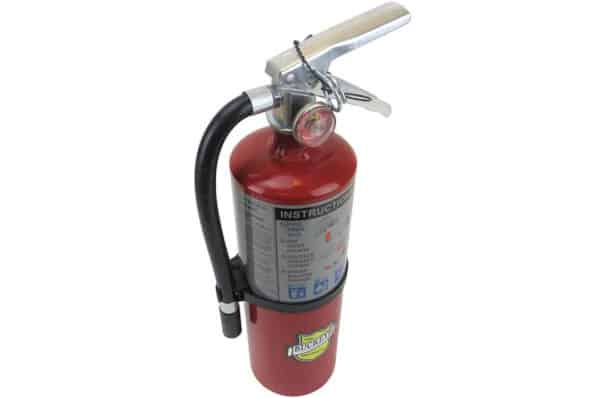
The pros of fire extinguishers
They are very effective when used properly
Fire extinguishers are relatively easy to use, and a study by the National Association of Fire Equipment Dealers (NAFED) showed they were “effective in extinguishing fires 95 percent of the time.” This, of course, applies when a fire is in a relatively early, containable stage. But even when a fire extinguisher could not completely put out the fire, the study found that it often limited damage and provided some degree of control over the situation until firefighters could arrive.
A wide range of sizes are available for different structures and threats
When seconds count, fire extinguishers can either stop a fire or give you time to retreat safely. We carry ABC fire extinguishers with capacities ranging from 2.5 pounds of dry chemical to 20 pounds. The capacities of the CO2 models range from 5 pounds to 20 pounds. For both the 2.5 pound ABC dry chemical and the 5 pound CO2 fire extinguishers, the continuous discharge time is rated at 9 seconds. In the 20 pound versions, the ABC fire extinguisher is rated to discharge continuously for 27 seconds, and the CO2 model can discharge continuously for 20 seconds.
The smaller extinguishers are recommended for vehicle, home, or office use, while larger ones are needed for bigger areas and those with more combustible materials, like warehouses or production environments. The capacity needed for a specific fire extinguisher is defined by National Fire Protection Association (NFPA) standards and codes, which we discuss in more detail in this guide.
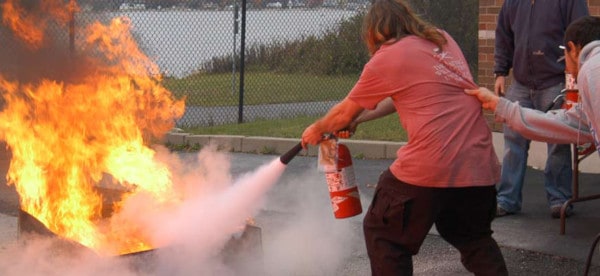
Fire extinguishers allow you to fight a fire from a safer distance
The range of a fire extinguisher also varies with its size and capacity, but all of them allow a user to stand off some distance from a fire. QRFS’s CO2 fire extinguishers are all rated for 4-8 feet of range, whereas ABC models gain a little more distance as they get larger. For example, the 2.5 pound Buckeye ABC fire extinguisher is rated for a range of 9-15 feet, while a 20-pound model is rated for 15-21 feet—allowing you to open up on the fire from the recommended distance of 8 to 10 feet. You can then work your way to the base of the fire if possible, or retreat if you are not able to contain it.
Fire extinguishers: cons and considerations
Using them requires some training
A fire extinguisher can be used by most people, but employing one safely and effectively does call for a bit of training. Note that Occupational Safety and Health Administration (OSHA) regulations require formal training for facilities under their jurisdiction.
The right way to use a fire extinguisher is often described by the acronym P.A.S.S:
- P – Pull the Pin.
- A – Aim the Nozzle at the Base of the Fire.
- S – Squeeze the Handles Together.
- S – Sweep Back and Forth.
While doing this, you should take care to begin spraying while standing at a safe distance, even if the spray is not quite reaching the base of the fire. You can move closer if the fire is dying out as you advance.
The P.A.S.S. technique is explained and demonstrated in this video:
Larger capacity fire extinguishers are heavy
The larger a fire extinguisher is, the longer it will be able to fight a fire—and the heavier it will be. People who lack upper body strength may struggle to pick up a larger fire extinguisher like a 20 lb. model or take it off a wall bracket safely. A 5 lb. model can be handled by most people, but it is, of course, lower in capacity and range.
Cleanup after discharge can be significant
If you’ve got a choice between a fire and a mess, you’ll choose the mess every time. But the cleaning required after using a fire extinguisher is something to consider. Our “Guide to Fire Extinguisher Clean Up” details the steps that you must take after a discharge.
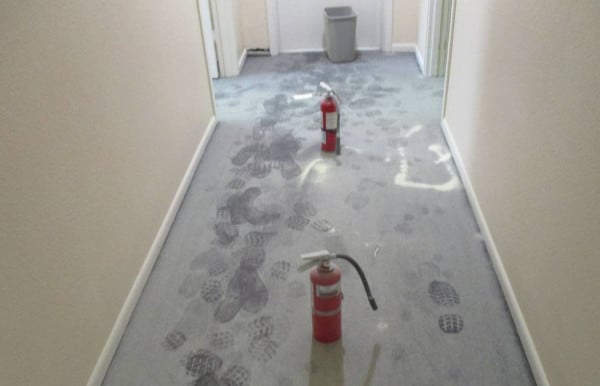
Cleanup needs vary by type, and common ABC fire extinguishers, unfortunately, leave a residue that is one of the more difficult discharges to handle. You may need professional help cleaning up after a discharge, especially if the residue has gotten into ductwork—the dry chemical is toxic, and you must avoid getting it into any waterways.
Fire extinguishers must be replaced or recharged after use
Once a fire extinguisher is used, it must be replaced or recharged, even if it was not completely discharged. Commercial grade fire extinguishers can often be serviced and recharged after use, but many inexpensive extinguishers, like those sold in retail stores, are designed for one use only and must be replaced.
The cost of replacing a fire extinguisher varies. For example, ours range from a little over $30 for a 2.5 lb. Buckeye ABC fire extinguisher to over $300 for our 20 lb. Buckeye CO2 model.
In contrast, recharging and doing full testing on a fire extinguisher usually ranges from about $20 to $70. Thus, it’s more cost-effective to recharge larger fire extinguishers, whereas smaller ones are often simply replaced. This is because much of the servicing cost is labor and parts—elements which are similar in expense regardless of capacity.
Fire blankets: a great option for containing fires and protecting people from flames—but not for fighting a fire that’s already spreading
Fire blankets work on a simple principle: smother the fire and deprive it of oxygen. To do this effectively, they have to be nonflammable themselves and provide as much of a barrier for heat and oxygen as possible. A modern commercial fire blanket will contain a fiberglass layer to achieve this purpose and the blanket will be designed to keep the fiberglass from coming in contact with skin.
A fire blanket should be mounted on a wall near (but not directly over) the area where it might be needed. For example, NFPA codes and standards stipulate that fire extinguishers be placed within 30 feet of cooking equipment, and it’s proper to place a fire blanket within this range as well. A fire blanket typically comes with a protective cover that clearly identifies it and instructs the user on how to extract the blanket.
Pros of fire blankets
They can be used for personal protection
If a person’s hair or clothing is on fire, wrapping them up in a fire blanket can be an important part of the “stop, drop, and roll” technique which is taught to minimize burns and injury. According to NFPA, blankets are especially useful if the person involved is not physically able to move rapidly due to age, medical condition, or physical limitations.
In a similar situation, discharging a chemical fire extinguisher around a person’s face could cause serious lung irritation, which could compound problems caused by smoke inhalation.
If a fire is out of control and you are surrounded by flames, a fire blanket may also help protect you and those you are helping if you must evacuate near areas exposed to flames.
Fire blankets contain fires in early stages, especially cooking fires
Cooking fires often start with a relatively small amount of grease in a container like a pan or pot. People are often reluctant to discharge a fire extinguisher because of the cleanup effort and expense involved, and Class K fire extinguishers are specifically required “for fires involving combustible cooking media (vegetable or animal oils and fats).” Sometimes, people pour or throw water onto a grease fire, with disastrous effects.
Putting a lid or pan over a fire in a container is the right idea—if done effectively, it will smother the fire. But it can be risky, because you may not have enough protection from the flames as you bring this cover down over them.
Using a fire blanket lowers this risk. FIRST, turn off the source of heat, if possible. A quality fire blanket will have straps to help you wrap your hands up completely to protect them. You must quickly drape the fire blanket over the fire without throwing it or fanning the flames. Once it’s on, leave it in place until you’re certain the fire is out.
This video from the fire department in New South Wales, Australia provides an excellent demonstration of how to use a fire blanket on a cooking fire:
Fire blankets can be used by people who might have difficulty with extinguishers
If upper-body strength is an issue, fire blankets sized like the Wilson and Cousins 60” x 78” fire blanket are easily handled, as they typically weigh no more than two to three pounds.
Some people are concerned about what will happen when they use a fire extinguisher and are confused by the different types of extinguishers available; they may not know exactly which one should be deployed. While these concerns can and should be addressed by training, using a fire blanket may be a more straightforward decision if a fire is small enough.
Cons and considerations of fire blankets
They are a one-use item
Fire extinguishers must be replaced or recharged after every use, whereas fire blankets should always be replaced after any use in a fire, even if they appear to be intact.
Older fire blankets may contain asbestos
The EPA instituted a partial ban on products containing asbestos in 1989 because of the serious risks of lung disease associated with the material. Asbestos was extremely common in fire blankets before that time. If you have any old fire blankets in your home or workplace that you suspect may contain asbestos, contact an asbestos removal specialist. Don’t use them, handle them, or disturb them.
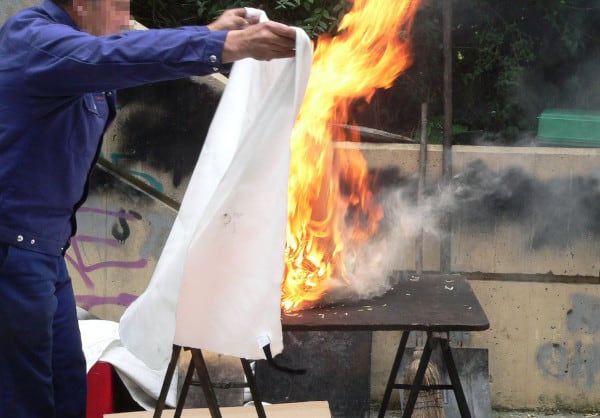
Fire blankets require you to get close to a fire
The correct technique to use a fire blanket requires you to place it right on top of a fire. If flames are high above the source or widespread, this may be difficult or impossible to do safely.
Fire blankets can’t be used safely on larger fires
If a fire is becoming widespread, a fire blanket can’t be deployed effectively. A typical fire blanket size is about five feet wide by six feet long. Sizes much larger than this can become unwieldy for one person to handle. If the fire is extensive, it’s not a good idea to attempt to use a fire blanket, except as mentioned above for personal protection.
Fire blankets also require a bit of training
Without proper training, it could be easy to panic while approaching a fire, causing you to drop or throw the blanket. This could make things worse by spreading flaming liquids or fanning the flames. If you fail to wrap your hands in the corners of the blanket, you could burn yourself. For all these reasons, deploying fire blankets should include some training in how and when they are used, just as you would for fire extinguishers.
Fire blankets and fire extinguishers each have a role in fire safety
You should not be without a fire extinguisher—they are required for commercial spaces and highly recommended for all homes. They can prevent or minimize damage before the fire department can arrive and often put out fires in their earlier stages. But while fire extinguishers are more familiar to most of us, especially in the US, you should consider adding fire blankets to your fire protection strategy.
A fire blanket may help avoid a cleanup effort and they are particularly useful for small cooking fires that are caught early. This piece of equipment could also be a life-saver for yourself, a family member, or a coworker if someone catches on fire or needs to evacuate near flames. Fire blankets are an especially good idea for kitchens and areas where vessels and containers might catch fire. And they are also worth considering if you have elderly or infirm people in your home or place of business—who may not be able to drop and roll to smother a fire on their person.
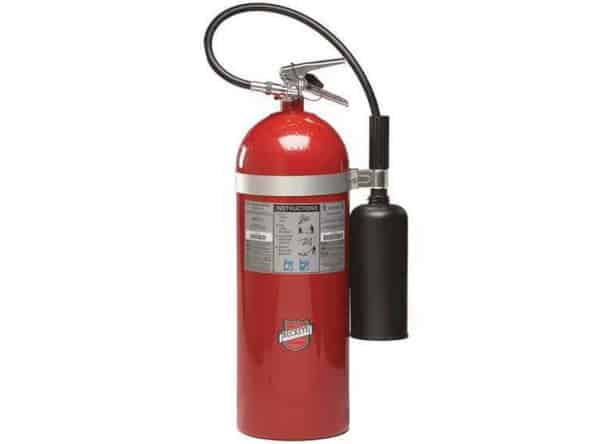
As a leading fire protection equipment supplier, QRFS carries a variety of fire extinguishers for home, commercial, and industrial use. QRFS carries a range of fire extinguisher signs, fire extinguisher covers, and fire extinguisher cabinets.
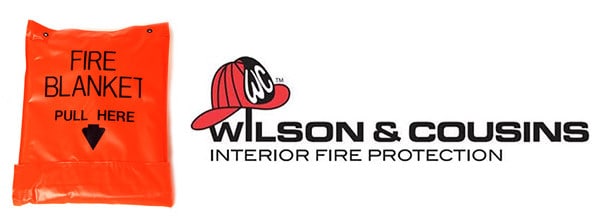
If you would like to purchase a fire blanket, QRFS carries a 60” by 78” Wilson and Cousins fire blanket that comes with straps and a protective cover. If you have any questions, call us at +1 (888) 361-6662 or email support@qrfs.com.
This blog was originally posted at blog.qrfs.com. If this article helped you learn something important about fire extinguishers and fire blankets, check us out at Facebook.com/QuickResponseFireSupply or on Twitter @QuickResponseFS.


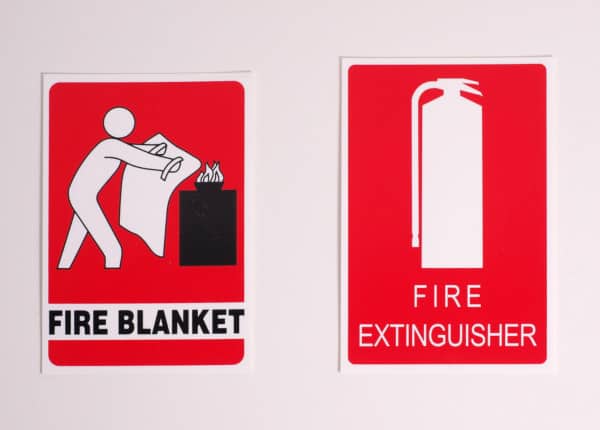
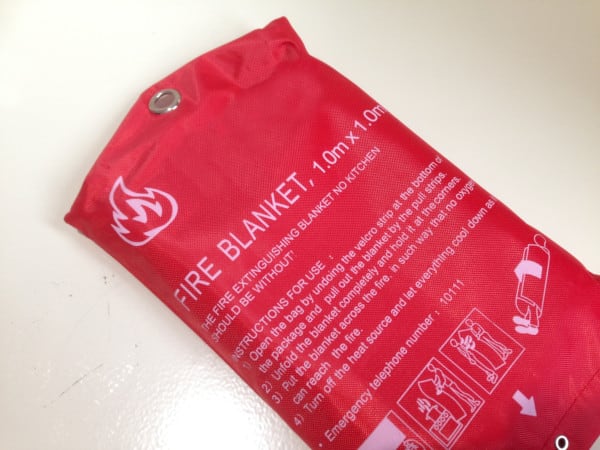
An ad I just viewed on Facebook about the fire blanket says it is reusable but your article says it’s a one time use. Please explain.
Reba, thanks for reaching out. In most instances, fire blankets can’t be used more than once. While there are a few fire blanket models that advertise themselves as reusable, any fire blanket that has put out a fire will be less effective in the spot where it previously came into contact with flames. It’s a good idea to throw away a used fire blanket as soon as it’s cool enough to do so. Here is an article with more information and reviews on fire blankets: https://www.chicagotribune.com/consumer-reviews/sns-bestreviews-safety-the-best-fire-blanket-20191114-story.html
How high is the temperature can the blanket resist? compare with fiberglass and asbestos ?
Most fire blankets can withstand about 1,000 degrees Fahrenheit for up to 1 minute and continuous temperatures of up to 750F, and many accomplish this through fiberglass. Asbestos has a higher temperature resistance but, of course, that material is not safe in many applications.
how often must a welding fire blanket be inspected?
Lynnea — a welding fire blanket is a (related but) different piece of equipment from the fire protection fire blankets covered here. At a minimum, blankets must be checked to ensure they are intact and meet ISO 9185 and EN ISO 11611 standards, etc. but intervals for inspections of specialized industrial equipment use are beyond our expertise. We recommend that you contact the welding blanket manufacturer and/or consult OSHA standards. Best of luck!
I have purchased a couple of fire blankets for my non-winterized cottage. Although they have never been used for a fire they have been in the cabin for a couple of years. We are finding when they are handled that they are leaving fibreglass particles in the skin. Is this normal and how often should they be replaced?
Thanks,
Karen
Karen — many fiberglass fire blankets will irritate skin whenever they are handled, which is why many manufacturers recommend wearing gloves while handling them and keeping them in their cover until needed in an emergency.
I have fire extinguishers at home. I do not have blankets, but it sounds like a very useful arsenal in homes. Thank you for the answers on the above questions, they are enlightening.
Hello, I see contradicting information on the internet about whether or not fire blankets are suitable to use in oil or grease kitchen fires. Could you comment on if a fire blanket is safe to use for those type of fires?
Diana — The main aspect of the conflict boils down to the fact that (Class K) extinguishers are safer and more effective because of their chemical makeup and allowable distance from the fire. A fire blanket operates on a similar principle to stopping a small grease fire in a pan by placing the lid over it, depriving the fire of oxygen (fuel). So, while a fire blanket can work to smother very small fires, it may be difficult to get close enough/completely cover things, especially without injury, where an appropriately rated extinguisher may be able to put it out easily and safely. In all cases, fire protection authorities advise only fighting a fire in its smallest stages — when it gets larger and spreads, evacuating and calling the fire department are the priority.
are fire blankets effective on electrical fires?
Alex — This is a good question we have not considered. A brief review of online sources have a few saying they are effective on small fires involving electrical equipment (appliances), at least one source saying they aren’t effective on electrical fires, and a company specifically selling large fire blankets designed to handle EV fires. Bottom line: we don’t know for sure and will need to do some more research. It’s a very good question, as electrical fires tend to burn long and hot. One item we can confirm is that fire blankets should only be used small fires in their very early stages.
I think that the fire blanket as a part of a fire safety arsenal as someone said is a great idea. Putting a lid on a pan on fire can be a challenge and of course you need an appropriate lid handy as well. I like it but would really like the public to become familiar with using these as well as extinguishers. Your local fire department can help you set up a program and maybe help collect out of date units that still have a charge in them. Teaching the best way to use them to the public can be a great start to better safety. Of course one needs to know when to quit can call for help rather than let the fire grow before making the call.